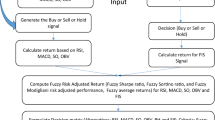Abstract
Both technical analysis and artificial intelligence are popular and promising approaches for the construction of intelligent financial application systems, but any particular method alone might not be sufficient. Instead of pursuing the construction of a perfect system using any one particular technique, this paper focuses on the study of the Intelligent Stock Selection Decision Support System (ISSDSS) that adopts both traditional technical analysis and artificial intelligence in dealing with the stock selection problem. ISSDSS analyzes the Taiwan stock market using various technical analysis techniques including technical indicators, charts analysis, Japanese candlesticks philosophy, and Dow theory, giving the basis for the evaluation of the price and trend of stocks, trading signals, and trading prices. AI techniques built upon fuzzy decision rules are employed to double-check the results from technical analysis. The performance of ISSDSS was evaluated by simulating the stock selection in the Taiwan stock market from January 1990 to April 1995. The result confirms that the synergy of technical analysis and artificial intelligence outperforms systems using any one particular technique alone.
Similar content being viewed by others
References
E. Cox, A model-free trainable fuzzy system for the analysis of financial time-series data, 2nd International Conference on Artificial Intelligence Applications on Wall Street, 1993, pp. 280–285.
G.J. Deboeck, Trading On The Edge, Wiley, 1994.
G. Du, Apply Technical Indices to Taiwan Stock Market, Fei-Fan Inc., Taiwan, 1992.
R.D. Edwards and J. Magee, Technical Analysis of Stock Trends, John Magee, Inc., 1974.
M.L. Gargano, P. Chamoun and D.L. Von Kleeck, Using genetic algorithms to solve financial portfolio problems related to optimal allocation, portfolio insurance, and performance, 2nd International Conference on Artificial Intelligence Applications on Wall Street, 1993, pp. 137–143.
D.E. Goldberg, Genetic Algorithms in Search, Optimization, and Machine Learning, Addison-Wesley, 1989.
Y. Hiemstra, A stock market forecasting support system based on fuzzy logic, Proceedings of the 27th Annual Hawaii International Conference on System Sciences, 1994, pp. 281–287.
G.S. Jang, F. Lai, B.W. Jiang, C.C. Pan and L.H. Chien, An intelligent stock portfolio management system based on short-term trend prediction using dual-module neural networks, Proceedings of the International Conference on Artificial Neural Networks, Finland, 1991, pp. 447–452.
P.J. Kaufman, The New Commodity Trading Systems and Methods, Wiley, New York, 1987.
C.C. Klimasauskas, Hybrid fuzzy encodings for improved backpropagation performance, Advanced Technology for Developers (September 1992).
G.J. Klir and T.A. Folger, Fuzzy Sets, Uncertainty, and Information, Prentice-Hall, 1992.
B. Kosko, Neural Networks and Fuzzy Systems, A Dynamical Systems Approach to Machine Intelligence, Prentice-Hall, 1992.
H. Markowitz, Portfolio selection, Journal of Finance, (March 1952).
G.L. Morris, Candle Power, International Publishing Company, Taiwan, 1994.
J.R. Quinlan, Induction of decision trees, Machine Learning 1(1986)81–106.
E. Rich and K. Knight, Artificial Intelligence, McGraw-Hill, 1993.
R.J. Bauer, Jr., Genetic Algorithms and Investment Strategies, Wiley, 1994.
F. Wong, Hybrid neural network for stock selection, 2nd International Conference on Artificial Intelligence Applications on Wall Street, 1993, pp. 294–301.
T. Yamaguchi and Y. Tachibana, A framework for rule base refinement in a stock market technical analysis — towards discovering anomaly from Granville's Law, 2nd International Conference on Artificial Intelligence Applications on Wall Street, 1993, pp. 259–268.
Rights and permissions
About this article
Cite this article
Chou, Sc.T., Hsu, Hj., Yang, Cc. et al. A stock selection DSS combining AI and technical analysis. Annals of Operations Research 75, 335–353 (1997). https://doi.org/10.1023/A:1018923916424
Issue Date:
DOI: https://doi.org/10.1023/A:1018923916424




